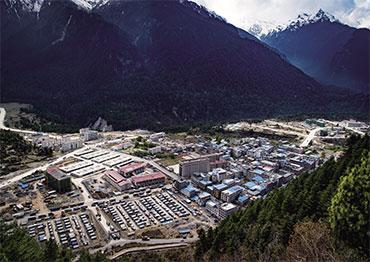After India-Nepal land routes were blocked due to strikes and protests in southern Nepal in response to constitutional changes in September 2015, which India was suspected of assisting according to media reports, the cross-border rail project gained new momentum in Nepal. As Nepal relies solely on India for fuel products and depends heavily on India for food, medicine, and other key commodities, the blockade caused a severe medicine and fuel crisis.
Although the “undeclared Indian blockade” was lifted in January 2016, when Nepal bowed to the pressure and changed its constitutional amendment bill, Nepal took more seriously the prospect of securing an alternative supply route. The only other choice for Nepal, a landlocked nation sandwiched between China and India, is a land route via Tibet.
During the blockade, China came to Nepal’s aid by agreeing to provide more than 1,000 tons of fuel as a grant and signed a deal with Kathmandu to export fuel products to the country.
In 2016, the two countries signed a trade and transit agreement, which granted Nepal access to seven Chinese ports, including four sea ports and three land ports, where Nepal can import goods for transshipment through a tariff-free agreement with China.
But without a railway that offers affordable and reliable transportation, these deals have done little to expand Nepal’s connectivity to the outside world.
In May 2017, Nepal joined the BRI, signing a Memorandum of Understanding (MoU) on bilateral cooperation. In June 2018, KP Sharma Oli, who became Nepal’s prime minister in 2015 and was re-elected in 2018, made an official visit to China, during which the two sides signed agreements including on cooperation on railway connectivity.
In October 2019, Chinese President Xi Jinping visited Nepal. Forging a “strategic partnership,” the two sides agreed on a feasibility study on the trans-Himalayan railway.
But only two months later, the Covid-19 pandemic erupted, disrupting bilateral traffic and putting the project on hold.
In May 2021, Oli, a major advocate of closer ties with China, was ousted from power by Nepal’s Supreme Court and was replaced with Prime Minister Sher Bahadur Deuba. From a different party, Deuba favors closer ties with India and the West.
Under the Deuba government, the Nepali congress ratified the Millennium Challenge Corporation (MCC) agreement on February 27. Involving the MCC, a major US development agency, the agreement includes a US$500 million grant to improve Nepal’s infrastructure, mostly energy transmission lines.
But the controversial agreement immediately sparked protests and riots on the streets of Kathmandu, with critics arguing that some of its clauses, including exempting US MCC officials from prosecution under Nepali law, creating a new US-controlled entity that would bypass Nepali authorities, and requiring Nepal to export hydropower to a monopsony market in India, undermine the country’s sovereignty. Others deem the deal as the soft arm of Washington’s Indo-Pacific strategy aimed at containing China.
In March, Chinese Foreign Minister Wang Yi traveled to Kathmandu to reassure that China would provide the development assistance President Xi committed in his Nepal October 2019 visit. The two sides signed nine agreements, including one on a feasibility study for the cross-border railway. Other agreements included those on economic and technological cooperation, power grid interconnection, trade and Covid-19 vaccines.
After China agreed to fund the feasibility study, there is finally some concrete progress. But given the complexity of the rail project, it will still take years, if not decades, to realize. According to a report in the Kathmandu Post in March, Chinese officials told their Nepali counterparts that the feasibility study alone will take at least 42 months to complete.

 Old Version
Old Version



